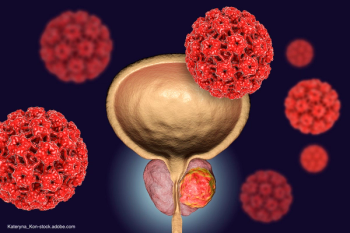
“The takeaway from that talk was that it's critically important to review drug plan options, particularly if the patient's on a high-cost drug,” says Kelly L. Stratton, MD, FACS.

“The takeaway from that talk was that it's critically important to review drug plan options, particularly if the patient's on a high-cost drug,” says Kelly L. Stratton, MD, FACS.

“I think [it was a] great opportunity to catch up on what is going on with PSMA-PET and theranostics and then also understand that that landscape will change over the near future,” says Kelly L. Stratton, MD, FACS.

“Perspectives on testosterone therapy and its use as it pertains to prostate cancer have certainly progressed over [the] years,” Diana Magee, MD, MPH, MSc.

“This study highlights how treatment remains influenced by where you live,” Diana Magee, MD, MPH, MSc.

“It's a really simple tool to predict your out-of-pocket costs,” says Benjamin Pockros, MD, MBA, of Medicare Plan Finder.

The phase 3 CAPTAIN trial was launched following the pivotal TACT trial, which showed that TULSA provided durable disease control with low toxicity at 3 years’ follow-up in men with localized prostate cancer.

Bipolar androgen therapy is being explored in trials with enzalutamide (Xtandi), olaparib (Lynparza), and nivolumab (Opdivo), explains Laura Sena MD, PhD.

“This is different from other standard-of-care therapies for prostate cancer because usually we are inhibiting androgen receptor (AR) activity and here we’re actually stimulating AR,” explained Laura Anne Sena, MD, PhD.

Specificity was between 93% to 97% and exceeded the threshold across all readers.

“The outcomes were similar between those who had normal or above, or below normal testosterone levels at baseline," said Kelly L. Stratton, MD.

“Preliminary efficacy data support proceeding to the phase 2 portion of this study,” the authors wrote in their poster conclusion.

The regimen consists of an alpha prostate-specific membrane antigen-targeted radionuclide therapy (225Ac-J591), an androgen receptor signaling inhibitor, and pembrolizumab.

The combination use of PSMA-targeted radionuclide therapy tailored by the individual patient and dose may show promise in the future treatment of men with metastatic castration-resistant prostate cancer.

Standard treatment is insufficient for some patients with high-risk localized prostate cancer, and the emerging field of theranostics provides a potential opportunity to improve outcomes, said Karen Elizabeth Hoffman, MD, MHSc, MPH.

Gerald L. Andriole, MD, and co-authors recently presented a study at the 2021 Society of Urologic Oncology Annual Meeting that investigates the novel imaging modality 18F-Fluciclovine PET scan for patients with biochemically recurrent prostate cancer.

“We do have a long way to go across the United States,” says Scott E. Eggener, MD.

“There was a point when people thought a trial [would] not be necessary because the answers [were] so clear cut. But obviously, more than just 1 person feels that these are not so clear-cut answers,” says Badar M. Mian, MD, FACS.

“One center would report 0.5% infection after transrectal. Another colleague may report 10%. That's a huge gap. And we have to understand why that gap is. The only way to find out will be through these randomized, controlled trials,” says Badar M. Mian, MD, FACS.

We have a lot of work to do to define how to optimize the integration of this therapy into what we call ‘advanced prostate cancer’,” says Michael J. Morris, MD.

“We want to make sure that if it is an efficacious medicine for that patient to consider using a generic formulation,” says Kelvin A. Moses, MD, PhD, FACS.

“The thought [for transperineal biopsy] is that if you can avoid introducing some rectal bacteria into the tissue, that we may be able to totally avoid or at least minimize the post-biopsy infections,” says Badar M. Mian, MD, FACS.

"It's comforting to know that the vast majority of patients will meet criteria for [lutetium PSMA], and therefore hopefully be able to receive that type of therapy," says Scott. T. Tagawa, MD, MS, FACP.

“We need to be aware of what patients are having to pay out of pocket, how it can impact their overall quality of life, [and] how can it impact their ability to pay for other necessities in life,” says Kelvin A. Moses, MD, PhD, FACS.

“[Polygenic risk scores] will help augment PSA screening and other tools to really figure out when we should initiate prostate cancer screening in men and how frequently that screening should occur,” says Isla Garraway, MD, PhD.

Transperineal biopsy can be used to lower the risk of infectious complications even if antibiotic prophylaxis is not used.

“Our data suggests that we shouldn’t just be relying on metastasis-directed therapy alone,” says Andrew J. Armstrong, MD, MSc.

“It’s really important to look at the pathology we’ve learned before considering these patients for active surveillance treatment,” says Isla Garraway, MD, PhD.

"The results of this trial impacted practice globally,” says Michael J. Morris, MD.

“For most men, we can identify the specific site or sites of recurrence, and thereby use a more directed therapy that specifically targets the abnormal sites,” says Gerald L. Andriole, MD.

“The good news for patients is that the survival and radiographic progression-free survival [were] substantially improved in all subsets,” says Andrew J. Armstrong, MD, MSc.